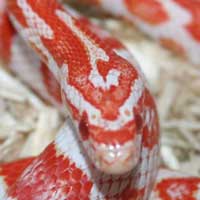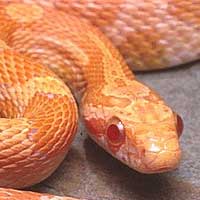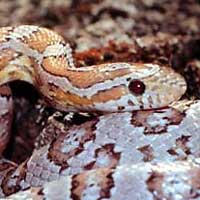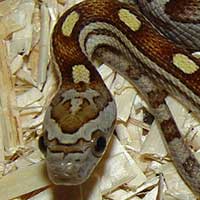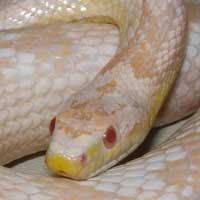Corn Snakes
How about a corny corn snake joke?
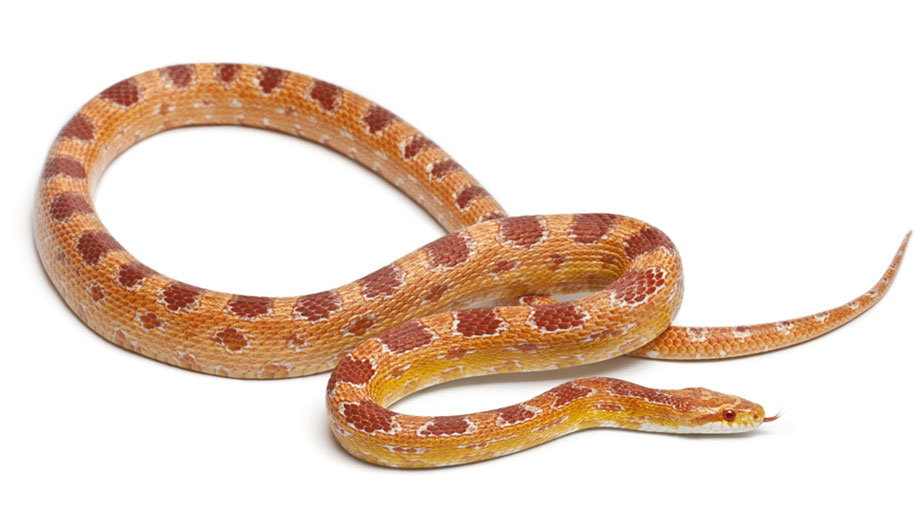
The corn snake (Elaphe guttata guttata), is a North American species that subdue their small prey with constriction much like boa constrictors. The name “corn snake” comes from the fact that they have a maize-like pattern on their bellies that resembles corn. You’ll notice that a lot of people will write the name as “corn snake.” In today’s day and age both “corn snake” and “corn snake” are acceptable but when following tradition the common name is spelled: “corn snake.” Their docile nature, reluctance to bite, moderate adult size (1.2-1.8 meters or 4-6 ft), attractive pattern, and comparatively simple care make them excellent and popular pet snakes. In the wild, they usually live around 10-15 years, but may live as long as 23 years in captivity. Corn snakes are non-venomous and extremely friendly.
The corn snake (Pantherophis guttatus) is a North American species of rat snake that subdues its small prey by constriction.
Though superficially resembling the venomous copperhead and often killed as a result of this mistaken identity, corn snakes are harmless and beneficial to humans.Corn snakes lack venom and help control populations of wild rodent pests that damage crops and spread disease. They can be distinguished from Copperhead snakes by their brighter colors, slender build and lack of heat-sensing pits.
Corn Snakes Are Amazing Creatures
Diet
Corn snakes are carnivorous and do not need to eat often. They eat every few days in the wild. They kill prey by constriction and consume anything smaller than they are, including other corn snakes.
RODENTS
AMPHIBIANS
BATS & BIRDS
REPTILES
EGGS
Reproduction
Males are polygynous; each male can mate with multiple females. Females may also have more than one mate in a season.
- Breeding occurs during the dry season (April-August), birth occurs 5-8 months later
- Mating System: polygynandrous (promiscuous)
- Range number of offspring: 10 to 64
- Average time to independence: after only a few minutes
- Average age at sexual maturity (female): 2-3 years
- Average age at sexual maturity (male): 2-3 years
Sub-Species & Morphs
If you’re curious, let one of these corn snakes bite you.
How to Take Care of a Corn Snake
Enclosure
Corns must be housed in at least a 20 gallon tank. The tank must have a secure top. A determined snake can push against screen or glass until it finds an opening big enough for its head; where its head goes, so goes its body. Some snakes will constantly rub their nose against the screened top of the tank in an effort to find a way out. The resulting abrasions should be treated with an antiseptic and antibiotic ointment. The furnishings in the enclosure should then be evaluated to provide a more natural environment.
Provide a Hiding Place
A hide box of some sort should be provided, and an interesting branch for climbing and resting. Branches collected from the wild will need to be debugged by soaking first in chlorine/water solution, then rinsed thoroughly, soaked in clean water, then left to dry in the sun. No special lighting is required.
Substrate
With corn snakes, there are a couple of different substrates that can be used, such as pine chips (not cedar chips, are toxic), indoor/outdoor carpeting and “Astroturf”. If you use the carpeting or Astroturf, you must wash it then let it dry thoroughly before it can be used in the tank again; have two pieces on hand which can be rotated. The snakes will often burrow under the chips or carpet/turf, so don’t be surprised if they are not always in view. If you use pine or aspen shavings or cypress mulch, the urine and feces can be scooped out with a cat litter scoop, with fresh chips added as needed. Be sure to remove soiled substrate as soon as possible; urine-soaked material become a breeding ground for bacteria and fungus. If you use this type of substrate you will have to place your snake in a secure area to feed it; you do not want it to ingest any chips.
Temperature
An undertank heat pad is placed under one-half of the tank; this leaves one side cooler so that your snake can regulate its body temperature as needed. A heating pad made for people can be purchased at any drug store; set it at medium or low depending upon the ambient air temperature. To maintain health, corn snakes must be kept at 75-85 F, the higher temperature being necessary to digest its food. Temperatures can fall to the lower range at night. To easily monitor temperature, inexpensive aquarium self-stick thermometers can be purchased and applied about an inch above the bottom of the tank on the warm side.
Hot rocks should never be used; they fluctuate too much, and too many reptiles suffer severe ventral burns.
An incandescent light bulb in a reflector shield may be set just outside the tank to heat up a basking area; appliance timers can be set to turn the light on and off at set times during the day. Reset the hours of operation to adjust for seasonal fluctuations in ambient air temperature.
Feeding
An active snake will happily eat every 10 days or so. They will eat, and should only be fed, killed prey. A snake who is not hungry when live prey is introduced into the enclosure often finds itself becoming the meal, especially if the prey is a rat.
To economize, you can buy in bulk and freeze them. Contact your local herpetology society; many members breed mice and rats, and most will pre-kill them for you. Remove the prey item from the freezer and allow to defrost at room temperature. When defrosted, use forceps or tongs to pick up the rodent by the tail, and hold the prey in front of the snake for the snake to strike at.
Many snakes will eat prey that is just placed in the tank. Occasionally, a quail egg can be offered to wild-caught specimens. If the snake likes it, one can be offered every couple of weeks. (Since quail eggs purchased in stores or from hatcheries are unlikely to be fertilized, they should not form a regular part of the main diet.)
Start hatchlings off with pinkie mice. As your snake grows, gradually increase the prey size by offering fuzzies, crews, then small adult mice or rat pinkies. A full-grown Corn or Rat can eat a medium to large mouse; large Rat snakes can eat small rats. If you feed too much at one feeding session, or feed a prey item that is too large, your snake may regurgitate it.
Water
A bowl of fresh water must always be available at all times. It will be used for drinking and sometimes for bathing. If the snake defecates in it, the bowl must be cleaned and disinfected immediately.
Handling
Corns do not wrap snugly around your arm like pythons or kings. They tend to pick a direction and go for it. Though they are relatively small in body mass, they are quite strong. Always support the body and give free rein to the head. If the head starts going somewhere you don’t want it to go, gently guide it into another direction. Many snakes are nervous when introduced into a new situation with new people. Give them a couple of days to settle down before letting new people handle them.
Shedding
As a reptile grows, its old skin become too tight and worn. A new skin awaits just below the old. As a snake gets ready to shed, its eyes will turn a milky blue over the course of several days, and the body color will start to dull and develop a whitish sheen. Once the eyes have cleared, the snake is ready to shed. To assure proper hydration, soak the snake in warmish water after the eyes clear; this should enable to snake to shed easily within the next 24 hours.
Veterinary Care
All newly acquired reptiles should have fecal exams done by an experienced reptile vet to check for bacteria, protozoa and worms. Many of the parasites, bacteria and protozoans can be transmitted to humans and other reptiles. Left untreated, these infestations can ultimately kill your reptile. Medications are available to treat these conditions. When your snake first defecates, collect the feces in a clean plastic bag, seal it, label it with your name, phone number, date and your snake’s name, then take it and your snake to a reptile vet.
Signs of ill-health
Snakes, like all other animals, do get sick. Listlessness, failure to eat over several weeks or regurgitating meals can be signs of bacterial or endoparasite infection. Take these animals to a reptile vet, with a fecal or vomitus sample enclosed in a ziplock bag. Ectoparasites, such as ticks and mites, must also be dealt with. With proper instruction, this is something you can do yourself if the infestation is mild. Allowed to escalate, ectoparasites can kill their host. If the skin around the neck forms wrinkles and puckers, the snake is severely dehydrated and you must see a vet. The vet will either administer subcutaneous fluids or show you how to force fluids. Animals cannot digest food when dehydrated, so emaciation will set in if the condition is allowed to continue untreated. Then, respiratory infections, parasites and other problems, and possibly death, will occur. Thin, stringy mucous coming out of nose or mouth or changes in feces or urates (different color, consistency, frequency) signal a disease or infection. Observe your snake every day to be sure to catch any problems early. Treat the problem as soon as it is noticed to prevent other health problems and vet bills.

